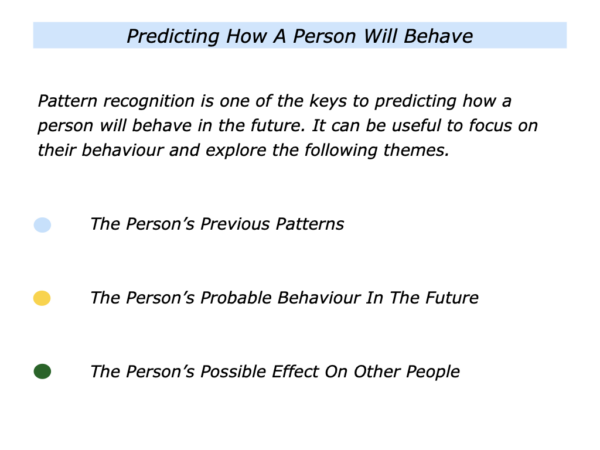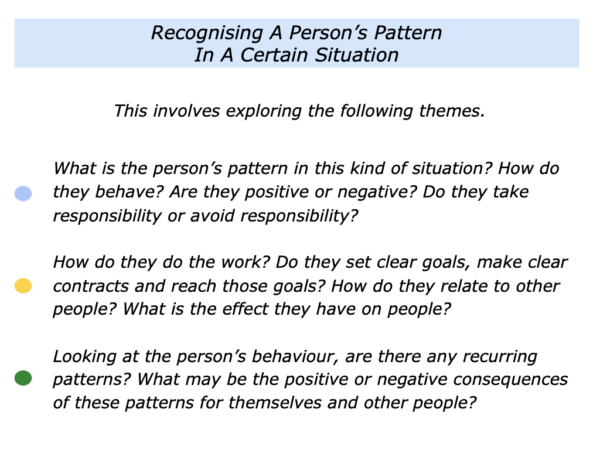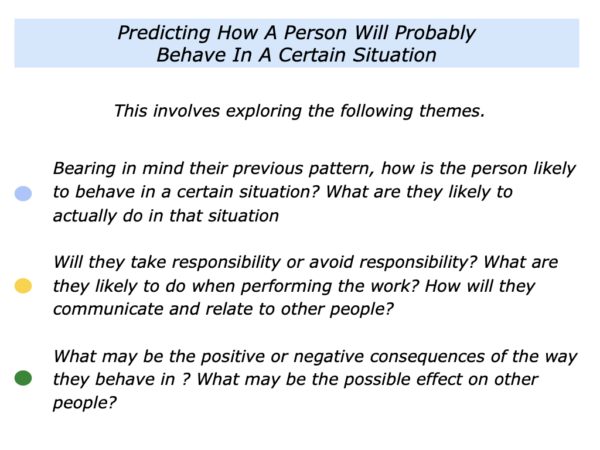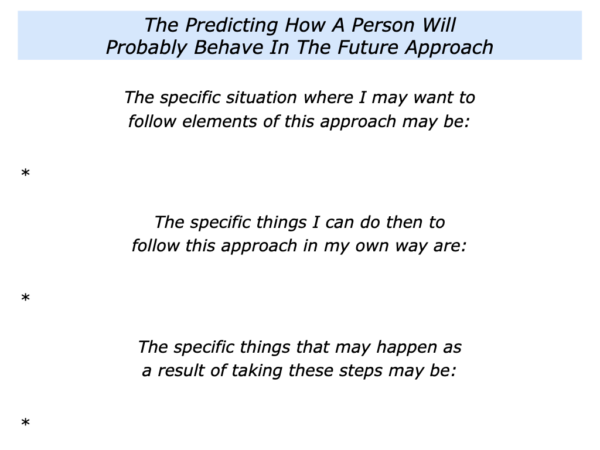
There are many models for predicting how a person may behave in certain situations. One approach is to recognise a person’s patterns. This is based on the view that:
A person’s behaviour in the past is the most likely predictor of their behaviour in the future.
Several things are worth considering when focusing on a person’s behaviour. These include the following:
The person’s patterns of behaviour may be specific to certain kinds of situation;
The person may have positive or negative patterns that have consequences for themselves and other people;
The person may or may not be aware of the consequences of their patterns and the effects these have on other people.
The recognising patterns approach is one that I first encountered when working in therapeutic communities. When appropriate, the aim was then help a person:
To recognise their positive and negative patterns;
To recognise the consequences of their positive and negative patterns;
To recognise how to build on their positive patterns and manage the consequences of any negative patterns.
Let’s return to your own life and work. Imagine that you want to follow elements of the predicting how people will behave approach. You may want to do this in your personal or professional life.
Imagine that you lead a team and are considering a person for a certain role. If appropriate, you can focus on the following themes. (You can apply similar principles in other aspects of your life or work.)
You Can Clarify
A Person’s Patterns
You can start by clarifying a person’s patterns. Much depends, of course, on whether you already know the person. Sometimes this can help but it can also cloud your judgement. This is because finding a person’s pattern calls for asking specific questions. These can include the following.
How does the person behave in certain situations? What do they actually do? Can we give any examples? What are the consequences of their behaviour?
What happens if you do not know the person? It will then be important to do lots of research. You can aim to build up a picture of the person’s strengths and style of working.
If appropriate, you can also invite the person to describe their own style of working. Bearing in mind the results you want them to deliver in a potential role, you can invite them:
To describe a specific situation in the past when they delivered similar results to those required in the potential role;
To describe the specific things they did then – the principles they followed and how they translated these into action – to deliver those results;
To describe the specific things they would actually do to deliver the desired results in the potential role.
Let’s assume you have some information about the person. Here are some of the themes you can then explore regarding their pattern in certain situations.

You Can Clarify A Person’s
Probable Behaviour In The Future
Imagine that you have recognised some of a person’s behaviour patterns in the past. You have to been able to recognise:
The specific ways they often behave in certain situations;
The specific ways they take or avoid responsibility and the ways they relate to other people;
The specific ways that their behaviour has positive or negative consequences in certain situations.
You may be considering hiring a person for a specific role. They may be working as a leader, a customer account director, a team member, a specialist or in another role.
Looking ahead, what may be the kinds of situations where they need to do good work. Bearing in mind their pattern, how are they likely to behave in this situation? If you wish, try exploring the following themes.

You Can Clarify What You Want
To Do Regarding The Person
Imagine you have clarified how the person the likely to behave in a certain situation. You can then decide what you want to do regarding the person.
Much will depend, of course, on the actual situation. This can also be influenced by whether the decision is going to affect your personal or professional life.
Imagine you are a leader and are considering a person for a specific role. You may then explore the following themes.
What is the role? What are the results we want a person to deliver when doing this role? How would we rate their ability to deliver the goods in the role?
Imagine you are recruiting somebody to lead a team. What are the specific results we want them to deliver in terms of profits, product quality and people management?
Looking at the person’s pattern, how are they likely to behave in this role? For example, on a scale 0-10, what how would we rate their ability to lead a team in the following areas:
Delivering the required profitability: ___ /10
Delivering the required professional
standards, customer service and product quality: ___ /10
Delivering the required positive
environment and people morale: ___ /10
People develop, they seldom change. Bearing in mind the person’s positive and potentially negative patters, be realistic when giving your view of the ratings.
There are times, of course, when it is possible to help a person: a) to build on their positive patterns; b) to manage the consequences of any negative patterns.
The person must want to take this step. If so, then it is possible to provide them with practical strategies and tools they can use to build on their strengths and manage the consequences of any weaknesses.
Predicting how people will behave is not an exact science. But a person’s previous patterns are often the most likely predictor to their future behaviour in a certain situation.
Let’s return to your own life and work. Looking ahead, can you think of a specific situation where you may want to follow elements of this approach? How can you do this in your own way.
If you wish, try tackling the exercise on this theme. This invites you to complete the following sentences.



Leave a Reply